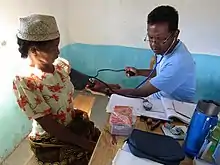Healthcare in Madagascar
Hospitals and small medical centers and posts are found throughout the island of Madagascar, although they are concentrated in urban areas and particularly in Antananarivo.[1]In addition to the high expense of medical care relative to the average Malagasy income, the prevalence of trained medical professionals remains extremely low. In 2010, Madagascar had an average of three hospital beds per 10,000 people and a total of 3,150 doctors, 5,661 nurses, 385 community health workers, 175 pharmacists and 57 dentists for a population of 22 million. The only hospital with a cancer ward is Joseph Ravoahangy Andrianavalona Hospital. 14.6 percent of government spending in 2008 was directed toward the health sector. Approximately 70% of spending on health was contributed by the government, while 30% originated with international donors and other private sources. The government provides at least one basic health center per commune. Private health centers are concentrated within urban areas and particularly those of the central highlands.

Access to health care
Since most of the hospitals, health centers and health posts are located in urban areas, access to medical care remains beyond the reach of many. Around 35% of the population live more than 10 km from a health facility.[2]
Health situation
Health services have shown a trend toward improvement over the past twenty years. There has been improved access to drinking water, intense malaria pre-elimination efforts and they have started campaigns to improve children's health.[2] Child immunizations against such diseases as hepatitis B, diphtheria and measles increased an average of 60% in this period, indicating low but increasing availability of basic medical services and treatments. The Malagasy fertility rate in 2009 was 4.6 children per woman, declining from 6.3 in 1990. Teen pregnancy rates of 14.8% in 2011, much higher than the African average, are a contributing factor to rapid population growth. In 2010 the maternal mortality rate was 440 per 100,000 births, compared to 373.1 in 2008 and 484.4 in 1990, indicating a decline in perinatal care following the 2009 coup. The infant mortality rate in 2011 was 41 per 1,000 births, with an under-five mortality rate at 61 per 1,000 births. Schistosomiasis, malaria and sexually transmitted diseases are common in Madagascar, although infection rates of AIDS remain low relative to many countries in mainland Africa, at only 0.2% of the adult population. The malaria mortality rate is also among the lowest in Africa at 8.5 deaths per 100,000 people, in part due to the highest frequency use of insecticide treated nets in Africa. Adult life expectancy in 2009 was 63 years for men and 67 years for women.[3]
Malnutrition
Madagscar has a malnutrition burden among its under-5 population. Numbers from 2013 shows us that the national prevalence of under-5 stunting is 48.9%, this is a lot higher than the developing country average which is 25%. Under-5 overweight has decreased from 6.2% in 2004 to 1.1% in 2013. Under-5 wasting national prevalence is 7.9%, which is less than the developing country average of 8.9%.[4] Around 75,000 children under 5 years have been treated for severe acute malnutrition since 2015. 50,000 were emergency cases.[5]
The adult population in Madagascar also face a malnutrition burden. 36.8% of malagasy women of reproductive age have anaemia, and around 6.3% of adult malagasy men suffers from diabetes. [4]
Measles
In 2018 a measles epidemic struck the island, with more than 117,000 people infected. Only 58% of people on the main island were vaccinated against measles. More than 1,200 people died, most of them children. Malnutrition, which is widespread, increased the rate of fatalities.[6]
References
- "A spatial database of health facilities managed by the public health sector in sub-Saharan Africa". World Health Organization. February 11, 2019. Retrieved May 8, 2020.
- "Madagascar Brief" (PDF). World Health Organization.
- "Primary health care: back to basics in Madagascar". World Health Organisation. Retrieved 16 November 2015.
- "Madagascar Nutrition". Global Nutrition Report.
- "Nutrition in Madagascar". UNICEF.
- "Madagascar measles epidemic kills more than 1,200 people". ABC News. 14 April 2019. Retrieved 14 April 2019.